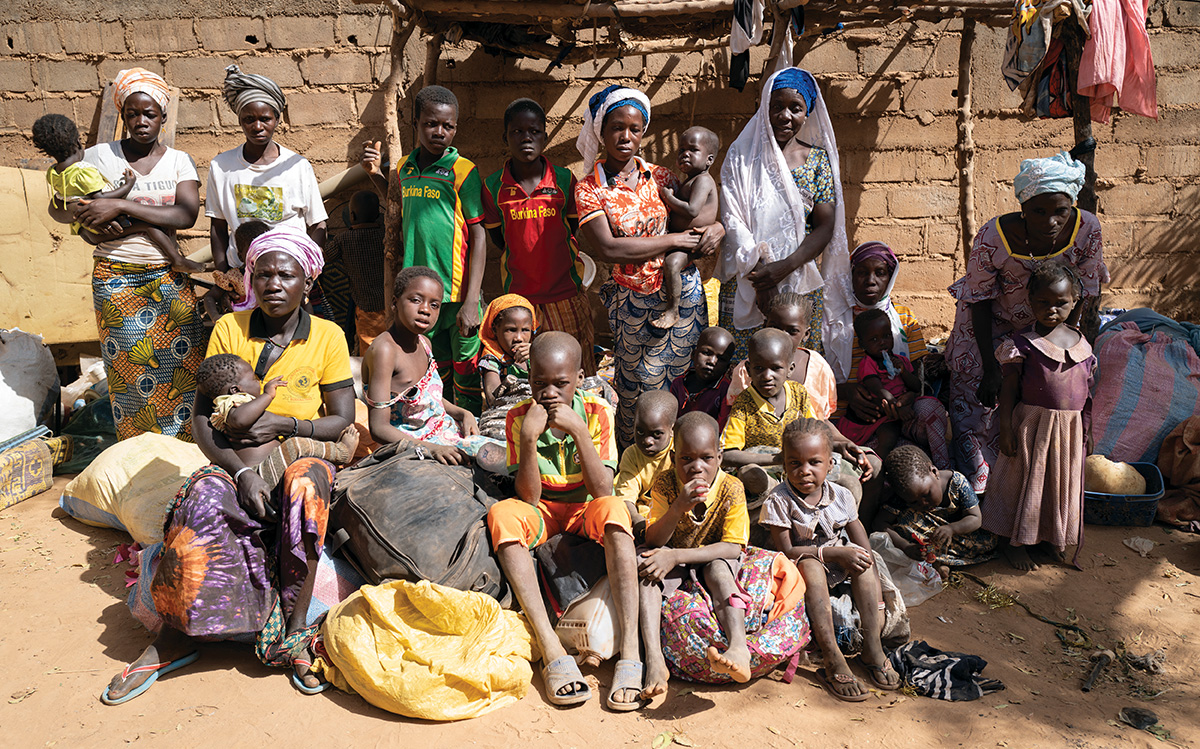Slaughter South of the Sahara: No Scope for “Business as Usual”
Comprehensive strategies—and contingency plans if they fail—are needed urgently to deal with the complex and rapidly deteriorating situation in the Sahel.
BY MARK WENTLING

In Kaya, Burkina Faso, on Feb. 4, 2020, displaced women and children of the Sawadoga family stand with everything they could carry from their home in Bokoum. They had been forced to flee just a few days prior to this photo being taken.
Courtesy of UNHCR / Sylvain Cherkaoui
The deteriorating security situation in West Africa’s vast Sahel region defies any simple description. Its complexity is exacerbated by numerous extremist groups, which seek through violent means to achieve their selfish and inscrutable objectives. Recent acts of violence by members of these groups serve as an urgent call to national governments and the international community to take additional steps to counter the groups, and protect vulnerable communities from the worst consequences of the increased instability brought about by mounting violence across the Sahel.
Of special concern are three Sahelian countries: Burkina Faso, Mali and Niger (Central Sahel). Since the military’s overthrow of an elected government in Mali in 2012 and the substantial outflow of arms and extremist fighters following the downfall of Muammar Gaddafi in Libya 2011, the level of instability and violence in the Sahel—and the number of incidents in these countries, in particular—has skyrocketed.
The military coup in Mali on Aug. 18 further destabilized a country that was once viewed as a model of democracy. There are also reports that the COVID-19 pandemic is playing into the hands of extremist groups, which are willing to take higher risks. It is feared that following historic seasonal rainfall in 2020 in the region these groups will become more aggressive.
Recent armed attacks on national military forces by extremist groups in these countries have resulted in extrajudicial killings of nearly 200 people this year by host-country militaries, and retaliatory attacks on the part of local militia have added to this number. These attacks have fomented intercommunal resentments and led to violence between ethnic groups. One example is the extrajudicial killing of 43 members of the Peulh ethnic group in Burkina Faso in March reported by Amnesty International. Also, corrupt activities by national military forces are not helpful. In this regard, the $100 million military procurement scandal revealed by an official audit in Niger in 2020 is lamentable.
The growing waves of violent extremism have introduced drug trafficking, corruption and criminality; collapsed local economies; undermined local and regional institutions and governance; exacerbated ethnic divisions; and prompted extensive displacement and migration. Without renewed engagement by the international community and a reasoned strategy to take on and defeat extremist violence, this scourge threatens to shatter the centuries-old traditions and social fabric of Sahelian society and could spread to envelop the entirety of West Africa.
On the Ground
UNHCR reports that the number of people internally displaced in Burkina Faso, Mali and Niger increased from nearly 300,000 in 2018 to almost two million by mid-2020. Burkina Faso has especially been hammered by the upsurge in violent extremist activity in 2019 and 2020; the number of people fleeing their homes doubled from nearly 500,000 to a million in less than a year. Large swaths of this country have almost ceased functioning, including the closing of hundreds of schools. All signs indicate that the number of homeless people will continue to grow, a somber indicator of the depth and extent of the conflict in the Central Sahel.
In Niger’s case, the prolonged upheaval in the Lake Chad Basin in the southeast corner of the country has been caused by Boko Haram, which has its base in northeast Nigeria. This group is reported to have caused more deaths than any other terrorist group in the world. The Council on Foreign Relations’ Global Conflict Tracker reports that Boko Haram is responsible for nearly 40,000 deaths since 2011, and the killing continues.
The conflict in this area has been exacerbated by the decline in livelihoods caused by the drying up of Lake Chad. Cross-border incursions of Boko Haram insurgents from their bases inside Nigeria have also obliged tens of thousands of local people to flee their homes. According to the Council on Foreign Relations, more than 2.5 million people have been displaced by the violence instigated by Boko Haram, and more than 240,000 people have taken refuge in neighboring countries (mostly Niger).
Perhaps the saddest case in the Central Sahel is Mali because formerly it was so full of promise. Of all the countries in the region, it has the most potential to achieve a higher level of prosperity for its people. Tapping this potential has been thrown off track for more than eight years, and with the recent military coup, it is now unlikely that Mali will ever achieve its full status as a democratic and economically prosperous country. In many ways, violent extremist groups have nixed Mali’s hopes for a better future, and the overthrow of a democratically elected president adds to Mali’s woes.
Simultaneously, the bloody acts of extremist groups have unleashed an unprecedented level of criminality and deepened traditional ethnic and communal cleavages. The growth and spread of extremists are aided by decades of weak governance and development failures. The groups thrive in the vast open geographic spaces of the Sahel, which have always been poorly governed or never had any governance at all. The failure of national governments to provide security and social services underlies the multiple grievances of the local population, and these can easily be exploited by extremists.
Also in this chaotic mix is the steady stream of thousands of migrants and asylum seekers from other African countries seeking refuge in Niger or a way farther north to desired destinations in Europe. The trafficking of migrants, drugs, arms and commercial merchandise continues to make northern Niger a crossroads for lucrative but illegal trade deals. Lately, the level of lawlessness in far northern Niger has been complicated by the discovery of gold in the remote Djado Plateau. The ensuing gold rush, fueled by the rise in international gold prices, has resulted in the influx of thousands of artisanal miners.
Most people in the Sahel wish to escape the clutches of absolute poverty, but the prospects of doing so are less than before. Living on the edge of survival has always been a challenge in the Sahel. Now, economic decline caused by increased insecurity and the spread of the COVID-19 pandemic is making the survival of even the most resilient inhabitants more difficult. And there is little, if any, hope in sight for any improvement in their precarious condition.
Factors to Consider
There are several important factors to be considered when analyzing the origin and growth of violent extremism in the Sahel and developing a strategy to stop it. For instance, the recession of Lake Chad is a reminder of how climate change, recurrent droughts and exceptional flooding can have profound effects. Most people living in the Sahel depend on agriculture or livestock-raising for their livelihoods, which are threatened by climate change, particularly increasingly variable seasonal rainfall. Climate change thus contributes to increased joblessness, which is a destabilizing factor of deep concern.
Further, a rapid population growth rate and a youthful population structure (on the average, one-half of the population is about 15 years old or younger) complicate a progressive erosion of livelihoods. Fast urbanization is also a demographic feature that sets off some alarm bells. Underlying the worrisome demographics of the Sahel is a relatively high and unsustainable total fertility rate. The current and projected demographic landscape contributes heavily to the deep poverty of the region and its fragility.
The growth and spread of extremists are aided by decades of weak governance and development failures.
One commonly voiced fear is that a large number of disaffected and unemployed youth will be attracted to violent extremist groups, thus becoming tomorrow’s foot soldiers for these groups. Large portions of the population who have never benefited from their respective national governments and those who view their government officials as corrupt elitists might also be easily swayed by what the extremists have to offer.
In some areas of the Central Sahel, rising population densities on less fertile land and overgrazed pastures are causing an increasing number of clashes between farmers and herders. The increase in the numbers of people and animals on the land force people to farm or graze more marginal lands, thus accelerating the negative effects of desertification and deforestation. Growing competition over increasingly scarce natural and water resources inevitably leads to conflicts.
Often, these conflicts are split along contrasting ethnic lines, making it easier for exploitation by violent extremist groups. These kinds of conflict can result in the creation of new armed groups that espouse ideologies designed to stimulate greater intercommunal conflict. And sometimes, extremist groups fight among themselves for supremacy, adding to the multiple layers of mistrust and mayhem.
Developing a Strategy
All-encompassing short-term and long-term strategies—and contingency plans if they fail—are needed urgently to deal with this situation. Yet any strategy must take account of certain realities.
First is the capacity of the host government to play the role necessary to stem the rising tide of violent extremism. Unlike extremist groups in the Middle East, extremist organizations in the Sahel do not appear to aim to overthrow national governments, but instead seek to undermine them by corrupting or killing individual officials who put their own interests ahead of what is best for their country. We need to understand: What do the extremists have to offer, and what is their ultimate purpose? What do they want?
If the host government is unwilling or unable in any way to take the necessary steps, activities designed to shore it up in a durable fashion need to be undertaken, and external support needs to be provided until host-country institutions are certified fully capable of executing key tasks independently.
Second, any strategy must include achieving peace and stability in Libya. The United States and its European allies need to flesh out a shared policy that solidly supports the United Nations’ effort to end Libya’s long civil war and stop the interference of foreign powers so that Libya can develop a strong unified government. Peace in
Libya is essential to achieving lasting stability in the Sahel. Libya became the trigger for increased violence south of the Sahara with the sudden demise of Muammar Gaddafi in 2011, which opened the floodgates for widespread extremist mayhem farther south. It appears that no thought was given to the havoc his removal would cause in this fragile part of Africa. Today, the porosity of Libya’s southern borders make stopping the illicit flow of arms and fighters into the Sahel impossible. Moreover, powerful vested interests in the lucrative cross-border trade will work to maintain the present chaotic situation.
Third, though the various extremist groups claim to be motivated by a religious zeal generated by their interpretation of Islam, this is in my view more a cover for their criminal acts than any true religious conviction. Therefore, I refrain from calling violent extremist actors “jihadists” because I do not see them acting from any deep-seated religious conviction. Their main interests appear to be in the domain of plunder and power. The United States, other members of the international community and regional bodies need to encourage and protect religious Islamic leaders who speak out against the destructive acts of extremist groups. Any radical Islamic preaching that promotes violence should be prohibited by the highest and most respected Islamic authorities.
It remains to be seen whether the international community will care enough during these challenging times about the troubles facing the Sahel to do as much as it can to obliterate the extremists and the conditions of poverty and weak governance they prey on. If not, the continued destructive impact of violent extremism will permanently change the face of the Sahel and, perhaps, West Africa as a whole. The Sahel region may very well be yet another casualty of the resource shortages caused by the COVID-19 pandemic.
Commitment Needed to Reverse the Trend
Centuries-old traditions and the social fabric that previously held Sahelian society together are bound to disintegrate. The longer the Sahelian conflict continues, the more likely that a younger generation will have never known a different life. A protracted conflict may cause a permanent cultural shift of unanticipated proportions. Certainly, the large gap between the outlooks of younger and older people will grow much wider.
The recent upsurge in bloody interethnic conflicts indicates that the trend in the Sahel will be difficult to reverse in the short term and will likely spread to other West African countries. Even with a viable strategy and committed resources, it could take a generation or more to stop the spread of violent extremism in the region. Meanwhile, the killing, destruction and displacement of tens of thousands more people will continue, aggravating the fragile conditions of these impoverished countries on the southern edge of the Sahara Desert.
Moreover, the upheaval in Central Sahel may well spill over into countries located farther south. It is logical to think that once extremists have gained a solid foothold in the Sahelian countries, they will expand their negative presence in coastal West African countries. What is there to stop their movement into Benin, Côte d’Ivoire, Ghana, Guinea and Togo?
While the crisis in the Central Sahel has been consuming large amounts of humanitarian funding from national and international relief organizations, there is no doubt that more aid is needed. Past assistance has not been wasted, but future assistance should be provided as part of an overarching strategy that includes all elements—humanitarian, economic, diplomatic and military—necessary for the stabilization of the Sahel.
The costs of caring for the more than one million refugees and displaced persons and the cost of foreign military assistance to combat extremist groups are substantial. Yet more will be needed, along with an unfailing long-term commitment by all concerned, if there is to be any hope of halting and repairing the damage done by the spread of violent extremism in the Sahel. There is no room for “business as usual” when dealing with such a protracted, multifaceted and rapidly deepening crisis.
Read More...
- “Predicting and Preventing Intrastate Violence: Lessons from Rwanda,” by David Rawson, The Foreign Service Journal, September 2019
- “Energy Diplomacy Works: How Power Africa Redefines Development Partnerships,” by Andrew Herscowitz, The Foreign Service Journal, March 2020
- “Situation in West Africa, Sahel ‘Extremely Volatile’ as Terrorists Exploit Ethnic Animosities, Special Representative Warns Security Council,” United Nations, July 9, 2020





